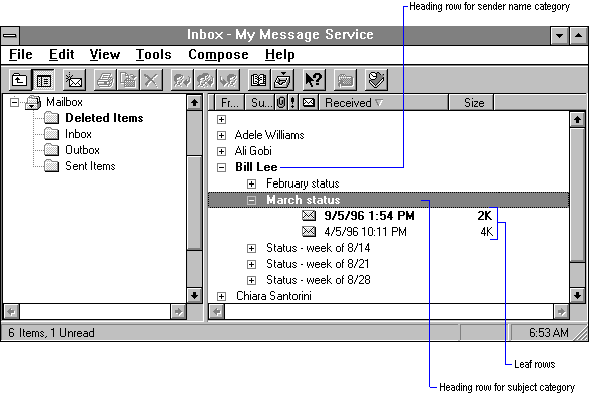
The SSortOrderSet structure defines a collection of sort keys for a table to be used for standard or categorized sorting.
| Header file: | MAPIDEFS.H |
| Related macros: | CbNewSSortOrderSet CbSSortOrderSet SizedSSortOrderSet |
typedef struct _SSortOrderSet
{
ULONG cSorts;
ULONG cCategories;
ULONG cExpanded;
SSortOrder aSort[MAPI_DIM];
} SSortOrderSet, FAR *LPSSortOrderSet;
An SSortOrderSet structure is used for defining multiple sort orders for standard and categorized sorting.
Each SSortOrderSet structure contains at least one SSortOrder structure defining the direction of the sort and the column to be used as the sort key. For categorized sorting, this column is used as the category. When the value of the cSorts member exceeds the value of the cCategories member, indicating that there are more sort keys than categories, categories are created from the columns that appear first in the SSortOrder array.
For example, if cSorts is set to 3 and cCategories is set to 2, the columns described by the ulPropTag member of the first two entries in the SSortOrder array are used as the category columns. The first entry serves as the top-level category grouping; the second entry as the secondary grouping. All of the rows that match the two category columns are sorted using the sort key defined in the third entry.
The following illustration shows how a contents table appears to a user in its expanded state. As in the previous example, the contents table is sorted using a categorized sort, with two columns acting as category columns and a third column as a standard sort key.

The cExpanded member specifies the number of categories that are initially expanded. When there are multiple categories, the table implementation begins with the first column to be designated as a category and continues in sequential order with the subsequent category columns until the number of cCategories has been exceeded. If there are more category columns than there are expanded columns, the category columns are collapsed. If cExpanded is equal to zero, only the top level heading row is available to the table user for display. If cExpanded is equal to one less than the number of categories, then all of the heading rows but none of the leaf rows are available. If cExpanded is equal to the number of categories, then the table is fully expanded.
For more information about standard and categorized sorting, see Sorting and Categorization.
Table Structures, IMAPITable::ExpandRow, IMAPITable::CollapseRow